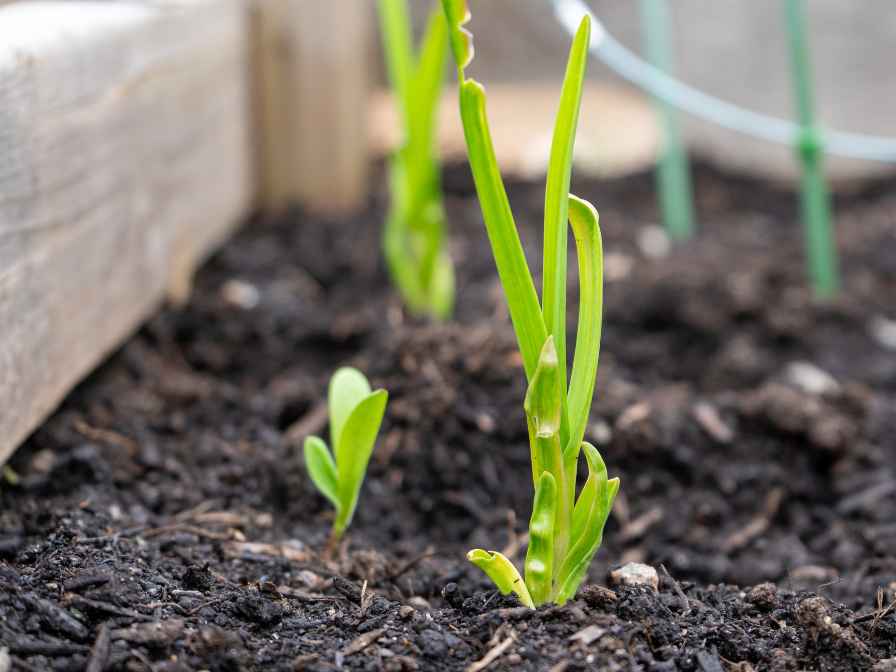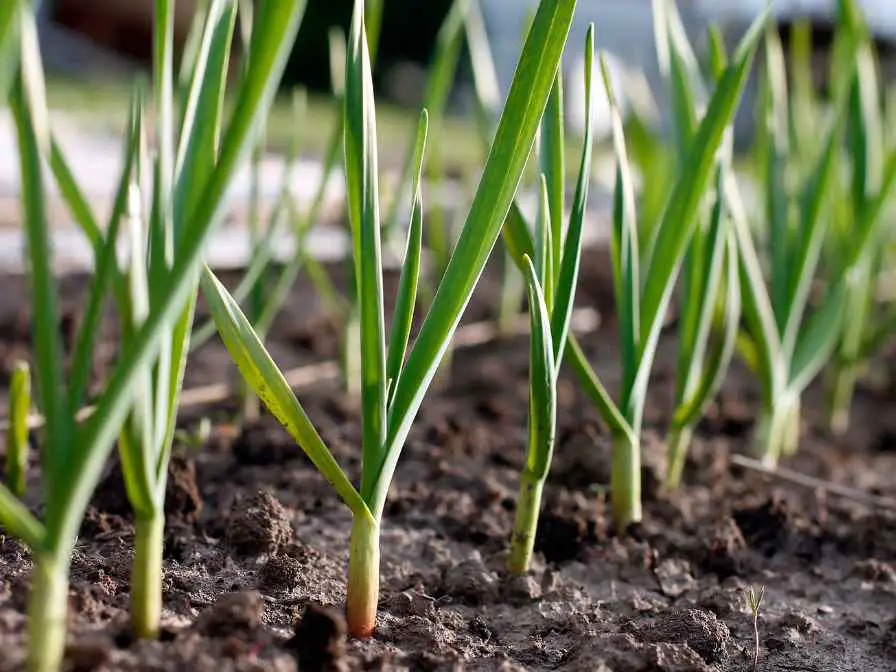Garlic is an important ingredient in the kitchen. It is used in many forms. It is also known and used for marination and other actions. As the head of garlic consists of cloves. You might be wondering whether growing garlic from cloves can be successful or not. Well, we are going to tell you about that.

Growing Garlic
Garlic (Allium sativum) is a species of plant in the onion family, known for its distinctive pungent flavor and aroma. It has been used for thousands of years in both cooking and medicine. and is a common component in a variety of international cuisines.
The cultivation and trading of garlic, which is a native of central Asia, dates back more than 5,000 years. Allicin and other Sulphur compounds, including other beneficial chemicals, are abundant in garlic. It gives garlic its distinctive flavor and smell.
These substances are thought to provide a variety of health advantages, such as decreasing blood pressure, strengthening the immune system, and lowering the risk of heart disease. Vitamins C and B6, manganese, and selenium are also present in garlic.
Garlic is used to provide flavor to a broad range of foods and may be consumed in a number of various ways, including raw, roasted, or cooked.
It is often used in Mediterranean, Asian, and Middle Eastern cuisine, and is a key ingredient in many traditional dishes, such as Italian spaghetti, Korean kimchi, and Indian dal tadka.
Garlic can also be taken as a supplement, in the form of capsules or tablets, although it is generally recommended to consume it in its natural form to obtain the full range of health benefits.
Benefits of Growing Garlic
Growing garlic has numerous benefits, both for personal consumption and for the environment. Here are some of the main benefits of growing garlic:
Fresh and flavorful garlic
Growing garlic allows you to have a fresh and flavorful supply of this culinary staple. Garlic that is grown at home is typically more flavorful than store-bought garlic. As it is harvested at the optimal time and not subjected to long periods of storage or transportation.
Health benefits
Garlic is famously known for its numerous medicinal benefits, which include reducing the risk of happening of heart disease, improving immune function, and reducing inflammation. Growing garlic at home allows you to have a readily available supply of fresh garlic. Which can be used in cooking or eaten raw to maximize its health benefits.
Cost-effective
Growing garlic can be a cost-effective way to obtain this valuable ingredient. Garlic is relatively easy to grow, and a single bulb can yield numerous cloves, which can then be used to grow additional bulbs. This means that once you have established a garlic crop, you can continue to harvest and replant your own garlic without the need to purchase additional bulbs.
Eco-friendly
Garlic is a relatively low-maintenance crop that requires minimal fertilizers or pesticides. By growing your own garlic, you can reduce your environmental impact by avoiding the use of harmful chemicals. By reducing the carbon footprint associated with the transportation and storage of commercially grown garlic.
Growing Garlic from Cloves

As a clove is a single unit in the head of the garlic, you can grow the garlic from cloves easily. You just have to follow some of the basic steps:
Choose the right time
Depending on your area and temperature, garlic is often planted in the fall or the first few weeks of spring. Garlic should generally be planted 4 to 6 weeks before the ground freezes in the autumn. Or as soon as the land can be worked in the early spring.
Select Healthy Garlic Bulbs
Choose garlic bulbs that are plump and firm, with tight skin and no signs of damage or disease. Break the bulb into individual cloves, making sure to keep the skin intact. Once cloves are ready do check again for any discrepancies.
Prepare the Soil
Garlic loves soil that drains well and is full of organic content. Make sure the soil is free of rocks and other debris, then amend it with compost or well-rotted manure. A soil pH ranging from 6 and 7 is also preferred for garlic.
Planting the cloves
Dig a shallow trench about 2 inches deep, and space the cloves about 4 to 6 inches apart, with the pointed end facing up. Cover the cloves with soil, and tamp them down gently to eliminate air pockets. You can easily plant the cloves in an organized manner i.e., in lines.
Water the cloves
Water the cloves well after planting, and then keep the soil consistently moist but not waterlogged. Garlic needs about one inch of water every week. When watering you should check for the upper layer moist.
Mulch the soil
Cover the soil around the garlic with a layer of organic mulch, such as straw or leaves. This will help to conserve moisture, suppress weeds, and regulate soil temperature. This is a sustainable way to grow garlic easily.
Taking Care of Garlic
Taking care of garlic after planting is relatively simple and requires minimal effort. Here are some tips for caring for your garlic crop:
Watering
Garlic needs consistent moisture to thrive, so make sure to water regularly throughout the growing season. You can go for a schedule of providing 1 inch of water every week. Be careful not to overwater, as this can lead to rot and disease.
Mulching
Mulching is an important step in caring for garlic, as it helps to conserve moisture, suppress weeds, and regulate soil temperature. Apply a layer of organic mulch, such as straw or leaves, around the garlic plants, taking care not to bury the stems.
Fertilizing
Garlic benefits from a balanced fertilizer, such as a 10-10-10 or 5-10-10 blend. Apply the fertilizer in the fall or early spring, according to the instructions on the package. Be careful not to over-fertilize, as this can lead to excessive leaf growth and reduced bulb size.
Weeding
Garlic is sensitive to competition from weeds, so it is important to keep the area around the plants free of weeds. Hand-pull any weeds that appear, being careful not to disturb the garlic plants.
Overall, garlic is a relatively low-maintenance crop that requires minimal care and attention. By providing consistent moisture, mulching, fertilizing, weeding, and harvesting at the right time, you can enjoy a bountiful harvest of fresh and flavorful garlic that can be used in a wide range of culinary applications.
Harvesting and Storing Garlic
Harvesting and storing garlic is an important part of the growing process. Here are some tips for harvesting and storing garlic:
Harvesting
Garlic is typically ready to harvest when the leaves start to turn yellow and dry out, usually in mid to late summer, depending on when it was planted. You want to harvest the garlic when it still has a few green leaves left, as this will help to protect the bulbs during the curing process. Use a garden fork or shovel to carefully dig up the bulbs, taking care not to damage them.
Curing
After harvesting, it’s important to cure the garlic to help it last longer in storage. Lay the bulbs out in a single layer in a warm, dry place with good ventilation, such as a garage or covered porch. Leave the bulbs to dry for two to four weeks, until the skins are dry and papery. This will help to toughen the skin and improve the flavor of the garlic.
Trimming
Once the garlic is fully cured, use a soft-bristled brush or your hands to gently remove any excess dirt or loose skin from the bulbs. Be careful not to damage the skin or remove too much of the papery layer.
Storing
Once the garlic has been cured and trimmed, it should be stored in a dry, and cool place with good ventilation, such as a pantry or root cellar. Do not store garlic in the refrigerator, as this can cause it to sprout or become moldy. Garlic can be stored for several months, depending on the variety and growing conditions.
In short, garlic is an important part of many dishes it can be easily grown from cloves. Just make sure the good care and you are good to go.
FAQs
How long does a garlic clove take to grow?
It takes quite a time. You can say it is a slow-growing vegetable. It takes 7 to 9 months to fully grow the garlic from cloves. You can assume it is like a human child. You have to take less care than that.
What is the best month to plant garlic from cloves?
It is planted in the fall, or you can say at the start of the fall. You need to plant the garlic in early October or in late September.
Do garlic cloves need to be dried before planting?
The process of drying and preparing the cloves for plantation is called curing. You need to cure the garlic cloves for 10 to 14 days in a ventilated, dark space. It will help in getting rid of humidity and other built-in diseases as well.

